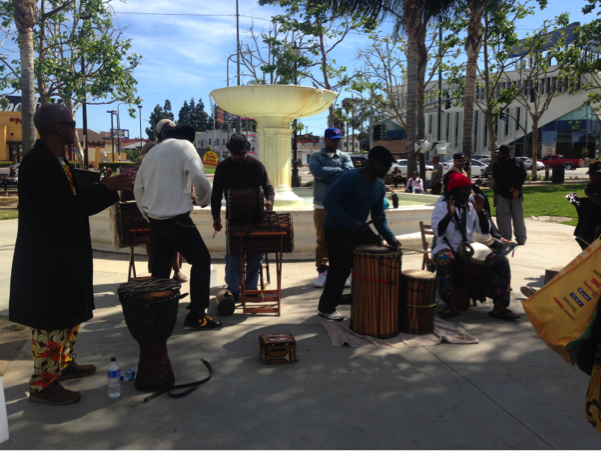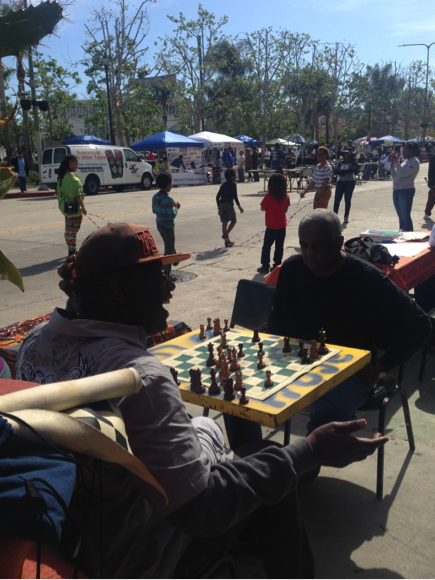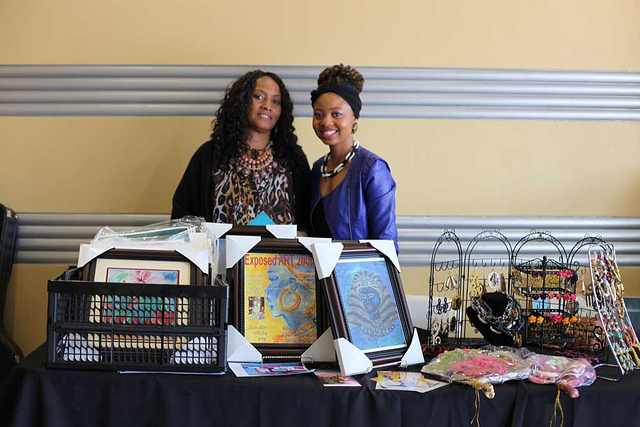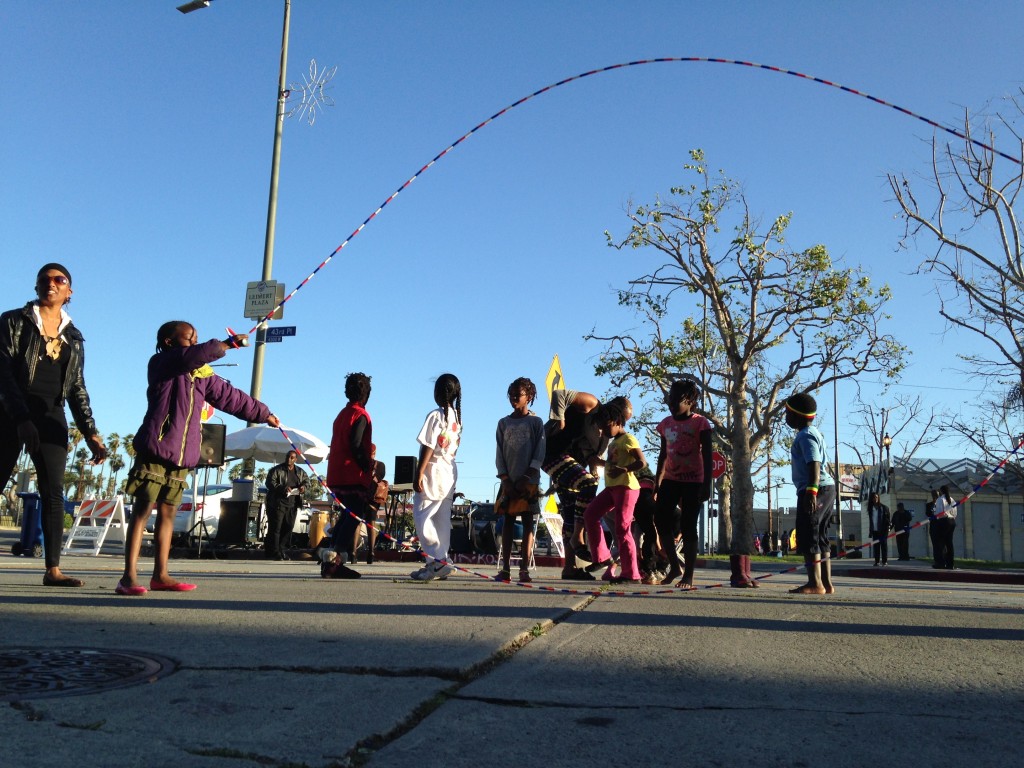
South Los Angeles residents, vendors and artists come together near the iconic white fountain in Leimert Park Village, a place of commerce and community. | Jordyn Holman
When Magic Johnson helped lead the Lakers to victory over the Boston Celtics in the NBA championship of 1987, South L.A.’s Leimert Park Village burst into festivities that ran late into the night. Jerri Wingo remembers residents breaking into joyous cries and blasting R&B music on boom-boxes, while restaurateurs cooked enough food to fill Wingo and her friends for days to come. Wingo also remembers that it was this moment that made her feel welcome in Leimert Park after moving to L.A. from a small town in Michigan.
Every weekend for nearly three decades, Wingo has set up shop in the grassy park that anchors the neighborhood. With a stand next to the iconic white fountain, she sells wide-framed sunglasses and Afro-centric pins along with handcrafted beaded necklaces and wooden earrings. Although she lives in Ladera Heights a few miles away, Wingo said events like the monthly Art Walk draw her back into the area for art, music and shopping.
For this reason, Wingo said she hopes Los Angeles City Council approves a proposal to permanently close off part of the street to create a pedestrian plaza, which she thinks would enhance the feeling of community.
See also from Intersections: Leimert Park Art Walk: Audio slideshow
The People Street program, a citywide initiative where neighborhoods can request the city’s help to turn underused streets and sidewalks into active and accessible public spaces, could help that happen. The project has garnered support among many Leimert Park residents and vendors. If the City Council approves the application, the Department of Transportation, in partnership with the mayor’s office and other city departments, would close off 43rd Place to cars — from Leimert Boulevard to Degnan Boulevard.
LADOT spokesperson Tina Backstrom said neighborhoods must gather a minimum of five letters of support from business owners and community members to demonstrate local engagement.
“You want to know people already want [the plaza] because they’re invested in the process,” Backstrom said.
When the plaza’s proponents submitted their application April 30, they had collected 102 written signatures and 124 online signatures in addition to 12 letters of support from community members and advocates, said Sherri Franklin of Urban Design Center, a contributor to the proposal.
The city is currently vetting the application for all the necessary components (such as organizational capacity and accessibility) to continue onto the next round. Next, the city would consider financial feasibility and other logistics. If the plan is approved, the city would paint the street surface and place large planters around the perimeter to define the plaza’s boundaries.
Wingo said she believes the plaza can help to boost Leimert Park’s sociable atmosphere.
“I want us to be free like we always were, listen to the drums until it’s dark and celebrate whatever we want to celebrate,” Wingo said during the April Art Walk as children played double-dutch nearby and customers sorted through her goods.
The possibility of creating a permanent plaza for commerce and culture has sparked discussion about how recreating the urban landscape would mesh — or perhaps clash — with the changing demographics and goals of both the residents and the city.
View Leimert Park in a larger map
A reason to be here
A year ago when the city of Los Angeles agreed to add a Metro stop at Leimert Park, expected to open in 2019, residents and stakeholders made sure there would be incentives for visitors to get off the train and spend time in the neighborhood. The monthly Art Walks on the last Sunday of each month, which encourage vendors and families to congregate around 43rd Place, aligned with this goal.
Many people attending the April Art Walk said the People Street initiative would be an ideal way to satisfy residents who have wanted a permanent space to showcase the neighborhood’s arts and culture. During the April and March Art Walks, community leaders closed off part of 43rd Place at Leimert Boulevard to show what the pedestrian plaza could eventually look like.
“We are looking to have a destination place for people to come, grab a sandwich, watch a show and have a reason to be here,” Franklin said. She also added it would be beneficial in the “park-deficient” region of South Los Angeles. “Leimert Park Plaza is one of the few parks people can congregate in and visit as a gathering place,” said Franklin, who worked closely with the petition process since the beginning.
Erika Auchterlonie, who has been living in Leimert Park for a year, brought her 9-year-old daughter Seven to the April Art Walk to create chalk-art masterpieces on the blacktop in the middle of Leimert Boulevard.
“It’s an under-appreciated environment and it needs to be used for more family activities,” Auchterlonie said.
Community organizers said the plaza could be used for activities ranging from art walks to dance shows. Many of these activities already take place in Leimert Park, but organizers often find themselves strapped for space. Residents, meanwhile, said they could set up tables for chess and painting areas for children.
Opening up space and ideas
Longtime residents and local scholars of African-American history consider Leimert Park the hub of Black culture in Los Angeles. Yet over the years, the neighborhood has experienced several distinct demographic shifts.
According to the 2010 U.S. Census, the aging population in the area is increasing. Currently, the median age of residents is 38, according to the Census Bureau. Furthermore, the once predominately Black area of South Los Angeles, which Leimert Park is a part of, is now two-thirds Latino, according to a 2011 report by the University of Southern California prepared for Community Coalition.
Enoch Mack, a 69-year-old artist and lifelong Leimert Park resident, said he has always viewed the area as a safe space designated for artists and residents. While attending the April Art Walk, he reflected on a time in the 1960s when the area abounded with galleries and musicians.
Mack said a permanent plaza could serve two purposes: It could maintain the art traditions of the area and protect a historically black part of the city.
“Leimert Park Plaza is the only place where blacks will collaborate to claim as their space,” Mack said. “It is being threatened on a daily basis and that’s why I support the petition.”
Other residents said the plaza could change unflattering perceptions about Leimert Park Village. For example, Franklin said some non-residents view Leimert Park Village as an unwelcoming part of Los Angeles. She believes the plaza would increase the visibility of the area, and help create a positive image.
“The plaza will help us solve some of the issues of people feeling safe,” Franklin said. “If they can see people jump roping, playing music and drawing in the middle of the street — you’re going to want to be there.”
A reason to stay
Many people in Leimert Park said it is complicated to coordinate the monthly Art Walk with city officials. The process requires a formal request to the city and a fee each time the neighborhood wants to block off streets for the cultural event.
Backstrom said that the People Street initiative could streamline the process of requesting an open space, such as the plaza, within Los Angeles.
“We took away the fear and confusion [about] how to get things done, and put it together into one packet,” Backstrom said.
Franklin agreed that the stability of a plaza would leave residents and vendors more time to focus on event planning rather than pouring all of their time and resources into permissions and logistics.
Now that the application period has closed, residents are getting a handle on both the long-term benefits and possible drawbacks of the plaza.
Wingo said the plaza would bring a feeling of belonging to Leimert Park residents and artists, but, if the plaza is implemented, she said she hoped that vendors’ would not have to pay extra fees to set up shop.
“We’re making our own things and I hope the city doesn’t turn this cultural place into someplace not affordable,” Wingo said.
Despite the economic uncertainty, several vendors, artists and newcomers to Leimert Park said they believe the plaza will revitalize the community.
“The beauty of this area is the culture and different experiences everyone has here,” Auchterlonie said. “We hope that with the help of the People Street plaza the rest of the city can see and learn from here. We just want to take this area to the next level.”
_____________________________________________________________________________________________________________
Click to discover more from Leimert Park’s third renaissance.
____________________________________________________________________________________________________________
Like Intersections on Facebook, follow us on Twitter and sign up for the Newsletter to stay in the loop on news and views from South L.A.


















Speak Your Mind